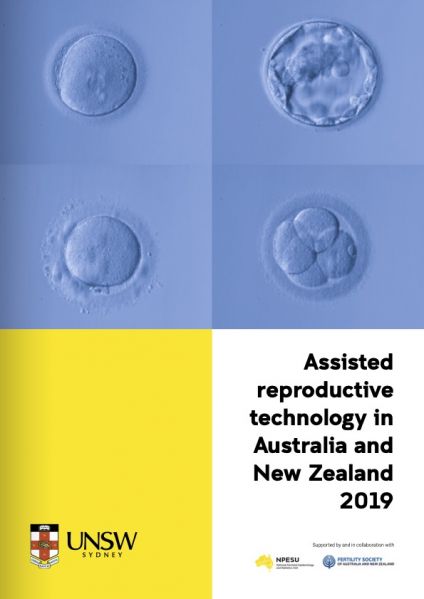File:Assisted reproductive technology in Australia and New Zealand 2019.jpg

Original file (595 × 841 pixels, file size: 68 KB, MIME type: image/jpeg)
Summary
Assisted reproductive technology (ART) is a group of procedures that involve the in vitro (outside of body) handling of human oocytes (eggs) and sperm or embryos for the purposes of establishing a pregnancy. Each ART treatment involves a number of stages and is generally referred to as an ART treatment cycle. The embryos transferred to a woman can either originate from the cycle in which they were created (fresh cycle) or be frozen (cryopreserved) and thawed before transfer (thaw cycle).
There were 88,929 ART treatment cycles reported from Australian and New Zealand fertility clinics in 2019 (81,049 and 7,880 respectively), representing an increase of 6.2% in Australia and 2% in New Zealand from 2018. This equates to 15.6 cycles per 1,000 women of reproductive age (15–44 years) in Australia, compared with 7.9 cycles per 1,000 women of reproductive age in New Zealand. Women used their own oocytes or embryos (autologous cycles) in 95% of treatments. Embryos and oocytes that had been frozen and thawed were used in 36.7% of autologous cycles.
There were 46,073 women who undertook 84,081 autologous fresh and/or thaw cycles in Australia and New Zealand in 2019. On average, 1.8 autologous fresh and/or thaw cycles per woman were undertaken in 2019, with more cycles per woman in Australia (1.8 cycles per woman) than in New Zealand (1.7 cycles per woman). The number of cycles where embryos were selected using preimplantation genetic testing (PGT) increased from 9,124 in 2018 to 10,748 in 2019. Over the last five years the proportion of cycles where all oocytes were cryopreserved for potential future use (oocyte freeze-all cycles) has increased from 2.5% of initiated fresh cycles in 2015 to 6.3% in 2019.
Over the same period the proportion of initiated fresh cycles that resulted in all embryos being cryopreserved (embryo freeze-all cycles) increased from 14.7% in 2015 to 21.7% in 2019. This practice is used for a variety of reasons, including reducing the risk of ovarian hyperstimulation syndrome (OHSS), improving endometrial - embryo synchronicity, as part of a PGT cycle or for fertility preservation.
- Assisted Reproductive Technology in Australia and New Zealand
Reference
Newman JE, Paul RC, Chambers GM 2021. Assisted reproductive technology in Australia and New Zealand 2019. Sydney: National Perinatal Epidemiology and Statistics Unit, the University of New South Wales, Sydney.
© Copyright UNSW Sydney 2021
Cite this page: Hill, M.A. (2024, April 27) Embryology Assisted reproductive technology in Australia and New Zealand 2019.jpg. Retrieved from https://embryology.med.unsw.edu.au/embryology/index.php/File:Assisted_reproductive_technology_in_Australia_and_New_Zealand_2019.jpg
- © Dr Mark Hill 2024, UNSW Embryology ISBN: 978 0 7334 2609 4 - UNSW CRICOS Provider Code No. 00098G
File history
Click on a date/time to view the file as it appeared at that time.
| Date/Time | Thumbnail | Dimensions | User | Comment | |
|---|---|---|---|---|---|
| current | 14:23, 23 December 2021 |  | 595 × 841 (68 KB) | Z8600021 (talk | contribs) |
You cannot overwrite this file.
File usage
The following 9 pages use this file:
- Assisted Reproductive Technology
- Australian Statistics
- File:Assisted reproductive technology in Australia and New Zealand 2013.jpg
- File:Assisted reproductive technology in Australia and New Zealand 2014.jpg
- File:Assisted reproductive technology in Australia and New Zealand 2015.jpg
- File:Assisted reproductive technology in Australia and New Zealand 2017.jpg
- File:Assisted reproductive technology in Australia and New Zealand 2018.jpg
- File:Assisted reproductive technology in Australia and New Zealand 2019.jpg
- Template:ART-ANZ-gallery









